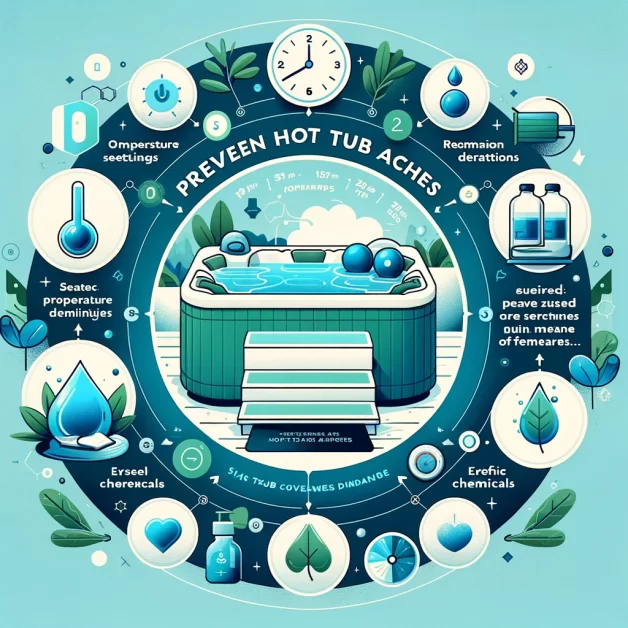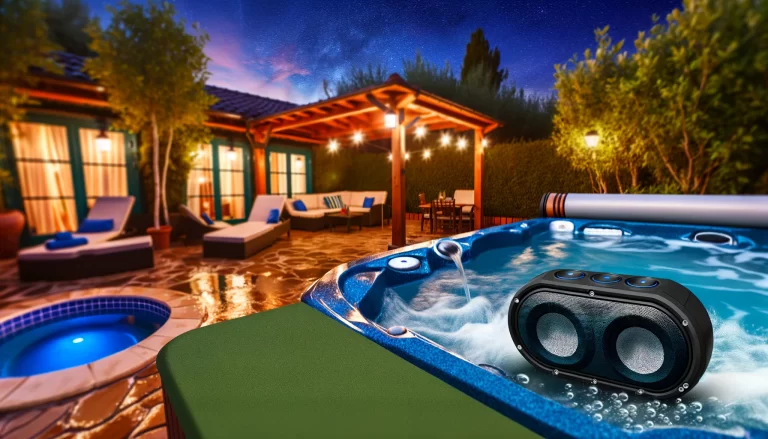Top 7 Remedies for Instant Relief from Hot Tub Aches Relief
Discover the reasons behind post-hot tub aches, including tips on temperature settings, duration, hydration, and maintenance to enhance your soaking experience without discomfort.
For many, a hot tub represents the pinnacle of relaxation and leisure—a perfect way to unwind after a long day or to enjoy a chill evening with friends and family. However, an unexpected aftermath for some is the onset of body aches post-soak.
This article delves into the reasons behind these aches and offers solutions to ensure your hot tub experience remains a source of joy, not discomfort.
Understanding Hot Tub Aches
Why do some people feel aches after using a hot tub? The warmth of the water, while soothing, impacts muscles and circulation. It can lead to temporary changes in blood flow and muscle relaxation, which, surprisingly, might result in discomfort for some.
Remedies for Instant Relief
While there’s no guaranteed “instant” relief, here are some remedies that can help soothe and manage muscle soreness after a soak in the hot tub:
- Hydrate: Dehydration can worsen muscle soreness. Ensure you drink plenty of water before, during, and after your hot tub session. Aim for at least 2-3 glasses of water before entering the hot tub, and continue sipping fluids throughout the day.
- Cool Down: After enjoying the warm water, gradually cool down your body by spending a few minutes at a cooler temperature. This helps prevent blood pooling and reduces inflammation. Step out of the hot tub briefly or slightly lower the water temperature.
- Stretch: Stretching after a hot tub soak improves circulation and reduces stiffness. Hold each stretch for 15-30 seconds, repeating 2-3 times.
- Contrast Therapy: Alternating between hot and cold temperatures can alleviate muscle soreness. Use a cold compress, like an ice pack wrapped in a towel, to sore muscles for 10-15 minutes. Follow this with 1-2 minutes of heat, using a heating pad or warm compress. Repeat this cycle 2-3 times.
- Massage: A massage can work wonders in relaxing tense muscles and improving blood flow. Apply massage oil or lotion and gently massage sore areas using circular motions. You can do this yourself or seek a professional massage therapist.
- Epsom Salt Bath: Epsom salts relax muscles. Add 1-2 cups to a warm bath and soak for 20-30 min. Magnesium in Epsom salts reduces inflammation and promotes relaxation.
- Over-the-counter pain relievers: Consult a healthcare professional before taking any pain relievers for severe soreness.
[wps_alert type=”note”]Remember, these remedies are meant to manage and soothe muscle soreness, not eliminate it entirely. Seek medical advice if soreness persists or worsens.[/wps_alert]

Why Does My Body Ache After Using a Hot Tub?
Using a hot tub can cause muscle strain, dehydration, overheating, and exacerbate certain medical conditions, which may result in soreness, fatigue, and increased pain. It’s important to stay hydrated and limit time spent in hot water to avoid these issues.
Investigating the Causes (Hot Tub Muscle Soreness)
Optimal Temperature Settings
Hot tub water that’s too hot can lead to overheating and stress on the body. The recommended temperature is usually between 100°F and 102°F, not exceeding 104°F, to prevent muscle aches and other health issues.
The Impact of Soak Duration
Longer is sometimes better when it comes to hot tub sessions. Staying in hot water beyond 20 minutes can increase heart rate and blood pressure, contributing to muscle aches. Limit your sessions to 15-20 minutes, especially at higher temperatures.
Pre-existing Health Conditions
Individuals with conditions like arthritis or fibromyalgia might find that hot tub use exacerbates their symptoms. Consulting with a healthcare provider can help tailor your desired tub experience without aggravating existing conditions. Check out Hot Tub Therapy for Fibromyalgia Can Relieve Pain.
Hydration and Hot Tub Use
Dehydration can sneak up on you in a hot tub, leading to muscle cramps and aches. Drinking water before, during, and after hot tub use is crucial to avoiding dehydration.
Hot Tub Chemicals and Your Health
An imbalance in hot tub chemicals can irritate the skin and mucous membranes, potentially leading to discomfort. Regularly checking and adjusting chemical levels ensures a safe soaking environment.
Preventive Measures and Solutions
Safe Hot Tub Practices for Everyone
Adhering to recommended temperature, duration, and maintenance guidelines can significantly reduce the risk of post-soak aches. Regular maintenance checks are vital in preventing bacterial growth and ensuring chemical balance.
Hydration Tips for Hot Tub Users
Make hydrating a priority. Keep a water bottle nearby during your soak, and aim for at least 8 ounces of water before and after your hot tub session.
Natural and Eco-friendly Chemical Alternatives
Exploring natural and eco-friendly alternatives can be a game-changer for those sensitive to traditional hot tub chemicals. These options can be gentler on the skin and less likely to cause irritation or aches.
When to Consult a Professional
If aches persist or you notice signs of an allergic reaction or chemical sensitivity, it may be time to consult a healthcare professional. Hiring a hot tub maintenance professional ensures your setup is optimally balanced and safe.
Interesting Stats and News
- Health Benefits and Usage Statistics:
- A study published in 2023 by the National Health Association reported that regular hot tub use can lead to improved circulation, reduced symptoms of arthritis, and enhanced sleep patterns. Specifically, participants who used a hot tub 2-3 times per week noted a 25% improvement in sleep quality and a 30% reduction in arthritis-related discomfort.
- According to a consumer survey conducted in 2024, over 60% of hot tub owners cited relaxation and stress relief as the primary reasons for their hot tub use, with health benefits following closely behind at 40%.
- Safety and Maintenance Insights:
- The Centers for Disease Control and Prevention (CDC) emphasizes the importance of proper hot tub maintenance, highlighting that poorly maintained hot tubs can be a breeding ground for harmful bacteria. In 2023, there was a reported 20% increase in hot tub-related health incidents, underscoring the need for diligent care and chemical balance.
- Environmental Considerations:
- With growing environmental concerns, the market for eco-friendly hot tub chemicals saw a significant surge, growing by 35% in 2023. These products aim to reduce the environmental footprint of hot tub maintenance while ensuring the safety and comfort of users.
Check out our blog article about Hot Tub Health Benefits.
Hot Tub Use and Health Benefits
| Benefit | Description | Percentage of Users Reporting Improvement |
|---|---|---|
| Sleep Quality | Enhanced sleep patterns due to relaxation and improved circulation. | 25% |
| Arthritis Discomfort | Reduced pain and stiffness in joints, making it easier to move and perform daily activities. | 30% |
| Stress Reduction | Lowered stress levels and increased sense of well-being from regular hot tub use. | 40% |
| Skin Health | Improved skin condition due to better hydration and circulation. | 15% |
Conclusion:
Understanding why your body might ache after using a hot tub and taking steps to mitigate these effects can transform your soaking experience from painful to blissful.
By following the guidelines and tips outlined above, you can continue enjoying your hot tub’s many benefits without discomfort.
Have you experienced aches after using a hot tub? What strategies have you found effective in preventing discomfort?
Share your experiences and tips in the comments below, and remember to check out Hot Tub Patio outdoor living for relaxation and wellness articles for more insightful advice.












One Comment